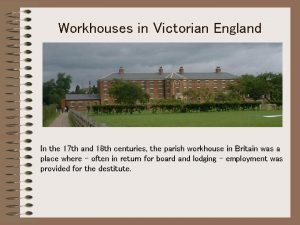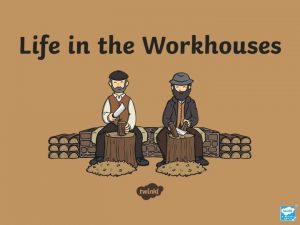Dietary Discipline and work in the workhouses Dietary









- Slides: 9

Dietary, Discipline and work in the workhouses

Dietary Within the workhouse they were given the option of six different diets, they could choose whatever suited their income. The Principle of ‘less eligibility’ had to be applied however they could not starve the inmates. Therefore the food was designed to degrade and humiliate. ‘Of this festive composition each boy had one porringer, and no more - except on occasions of great public rejoicing, when he had two ounces and a quarter of bread besides. ’ – Extract from Oliver Twist by Charles Dickens

How it operated • The inmates had to east in silence until 1842. • The paupers were served their food cold to add to the humiliation. • The food was of bad quality, the diets mainly consisted of meat, oat-meal, cheese and bread. • During the 1830’s the paupers were not allowed cutlery.

Andover Workhouse One infamous example was Andover Workhouse. Paupers were malnourished to such a degree they were eating the marrow and rotting meat they had been set to crush for work. Children had been so starved they scavenged the floor for raw potatoes thrown to the pigs, they even had their milk watered down.

Discipline • The workhouse were generally violent. The paupers and inmates often hurled verbal and physical abuse at each other. • It ranged from full scale riots to the exchange of foul language. • Among the paupers, Bullying and blackmail often occurred. • Sexual abuse between staff and paupers was also reported.

Rewards and Punishment • The staff had a complicated system of reward and punishment to maintain order. • They could be rewarded with extra food, pocket money and ‘cleaner’ work. • They could punished for banal reasons ranging from walking to slow to being in the wrong part of the workhouse. • There were specific punishments laid down by the poor law commissioners and a standard punishment book were all punishments were recorded.

The New System • Guardians and staff did at least know there were limits. They were universally applied by poor law commissioners. • Girls and Women could not be beaten however the reduction of rations was a common punishment. • Workhouses had punishment cells, though often the workhouse developed it’s own refinements. • Any serious crimes were dealt with by the law itslef.

Work in the workhouse • Work was viewed as an essential part of the workhouse. It was designed to rehabilitate the paupers for work outside of the workhouse. However, it couldn’t be more appealing the work outside the establishment. The pay was nothing or very little.

Odd-jobs • A lot of work was maintaining the workhouse, this included cooking cleaning and child-minding, this was mainly done by women and children. • A common job was oakum picking, which was unravelling twisted up old ropes so the fibres could be used again. • There was stone breaking, which was similar to the work of convicts it was very tiring. • Bone crushing was enforced, so the bone dust could be used as fertiliser. This was a health hazard as inhaling the dust was bad for your respiratory. The smell was also awful within hot climates.
















